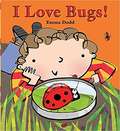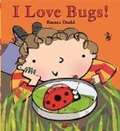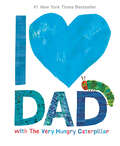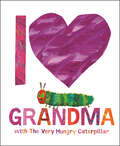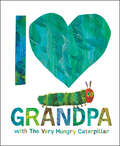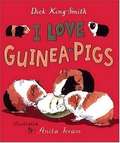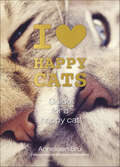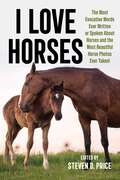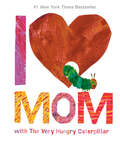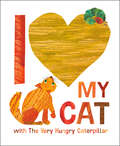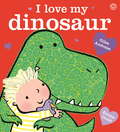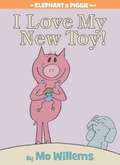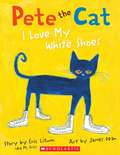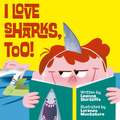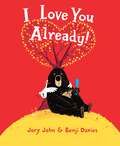- Table View
- List View
I Love Bugs!
by Emma DoddCome on a creepy-crawly bug safari through one little boy's garden . . . with a brilliant surprise at the end. Perfect for bug-lovers and budding scientists everywhere! With fun rhyming text and bright, bold artwork, perfect for sharing and reading aloud.
I Love Bugs!
by Philemon Sturges Shari HalpernWelcome to the world of bugs through a boy's journey to take pictures of all the bugs he finds. Picture descriptions added.
I Love Cats
by Media AdamsMore than 100 paw-some facts about your favorite furball!Did you know that cats sleep an average of thirteen hours a day, or that their hearts beat twice as fast as ours do? In I Love Cats, you'll discover more than 100 fascinating facts that will make you fall in love with your favorite felines all over again! From the trick behind their purr-fect balance to the adorable way they greet a new pal, you'll learn even more about your furry friend as you watch the kittens in this collection pounce their way into your heart.A heartwarming keepsake, I Love Cats is a must-have for any cat lover!
I Love Dad with The Very Hungry Caterpillar (The World of Eric Carle)
by Eric CarleShow Dad how much you care with this little message of love from The Very Hungry Caterpillar!Celebrate Dad's special day by saying "I Love You"--with a little help from The Very Hungry Caterpillar. This bright and colorful book is the ideal way to tell the person you call "Dad" how much you appreciate him. It's the perfect gift for Father's Day, Dad's birthday, or any day that you want to show Dad just how much you care. <p> <b>New York Times Bestseller</b> <P><P><i>Advisory: Bookshare has learned that this book offers only partial accessibility. We have kept it in the collection because it is useful for some of our members. Benetech is actively working on projects to improve accessibility issues such as these.</i>
I Love Dogs
by Patricia M. SherwoodDelve into I Love Dogs, a delightful collection of the most insightful, humorous, and heartwarming quotes from renowned figures that celebrate the joy, quirks, and enduring bond we share with our canine companions, making it the perfect read for any dog lover!I Love Dogs is a treasure trove of the wisest, funniest, and most heartwarming comments ever uttered about our beloved canine friends. From philosophers such as Jean-Paul Sartre to presidents such as Woodrow Wilson, an astonishing array of celebrated people have had all manner of things to say about our favorite animal—the dog. Included in this classic collection are such notable dog lovers as: Winston Churchill, T. S. Eliot, Robert Frost, Don Marquis, Willie Morris, Beatrix Potter, Anna Quindlen, James Thurber, Evelyn Waugh, and more. I Love Dogs is the perfect companion for a quiet night in front of the fireplace, a day in the park, or a stroll on the beach. The perfect companion, that is, short of a dog.
I Love Grandma with The Very Hungry Caterpillar
by Eric CarleCelebrate Grandma with The Very Hungry Caterpillar in this colorful book featuring Eric Carle's delightful illustrations!Join The Very Hungry Caterpillar as he honors grandmas everywhere! With cheerful illustrations and sweet sentiments, this heartfelt keepsake will show Grandma just how much you care.
I Love Grandpa with The Very Hungry Caterpillar
by Eric CarleGive lots of love to Grandpa with The Very Hungry Caterpillar in this colorful book featuring Eric Carle's delightful illustrations!The Very Hungry Caterpillar knows how special grandpas are, and this celebratory keepsake is the perfect way to honor them. Give the gift of love and show Grandpa how much you care with sweet sentiments and Eric Carle's charming illustrations. <p><P> <b>New York Times Bestseller</b>
I Love Happy Cats: Guide for a Happy Cat
by Anneleen BruCat behavioral therapist Anneleen Bru explains how cat owners can achieve perfect harmony with their feline friends.Cat lovers gain a deeper connection to their pets through tips, exercises, and an understanding of behaviors and desires.Note to self: ignore the cat to gain its attention.
I Love Horses (I Love)
I Love Horses gathers the most memorable quotes about horses ever written, recorded, or carried down through the ages, together with 50 fantastic photos of the prettiest horses available. Horses bring out the best in us; they inspire adoration and compassion. They have served as both muse and catharsis for artists and writers of all centuries and genres. Horses illuminate the prose of literary giants from Homer and Aesop to Steinbeck and Yeats and in sources that range from the Bible and Dante's Inferno to West with the Night, references to horses are abound. In I Love Horses, humorous remarks from the likes of Groucho Marx and Henny Youngman share the pages with valuable wisdom on training and horsemanship from widely honored trainers, past and present. What living creature is the most noble of all, and has spurred on great minds throughout history from Shakespeare to Winston Churchill? All hippophiles know the answer. It is the horse, of course. For all those in love with this magnificent animal, I Love Horses will reside close to the heart and never be far away. Includes wisdom from: Dave Barry Napoleon BonaparteLewis CarrollGeoffrey ChaucerCharles DickensEmily DickinsonWalter FarleyW. C. FieldsIan FlemingBenjamin FranklinSamuel JohnsonNikita KhrushchevRudyard KiplingGroucho MarxThomas McGuaneHerman MelvillePlatoDamon RunyonJ. D. SalingerWilliam ShakespeareJonathan SwiftAlfred, Lord TennysonMark TwainVirgil
I Love Kittens
by Heather HenningA little girl lists the reasons she loves kittens in this baby board book.
I Love Mom with The Very Hungry Caterpillar (The World of Eric Carle)
by Eric CarleCelebrate Mom's special day with The Very Hungry Caterpillar in this colorful book featuring Eric Carle's joyful illustrations.Show Mom just how much she means with this colorful book from the World of Eric Carle. Join The Very Hungry Caterpillar as he honors Mother's Day and celebrates incredible parents everywhere. With joyful illustrations and colorful creatures, this charming keepsake is a great way to show parents, grandparents, soon-to-be mothers, aunts, friends, or whomever you call "Mom" just how much you care.
I Love My Cat with The Very Hungry Caterpillar
by Eric CarleCelebrate beloved felines with help from The Very Hungry Caterpillar in this colorful book featuring Eric Carle's classic art. The perfect gift for honoring cherished pets throughout the year! My dear cat…You&’re curiousPlayfulAnd so very cute. Celebrate the bond between cat lovers and their cats with the Very Hungry Caterpillar! Complete with Eric Carle&’s classic joyful illustrations and featuring his favorite animal, this charming keepsake is a great way to celebrate cherished pets and show the cat lovers in your life how much you care!
I Love My Cat!: The All-Around Guide to Choosing, Grooming, Raising and Caring for Your Feline Friend
by Editors of Woman's DayMore than half of America 's pet owners consider their pet as much a part of their family as any other member and it's a fact that caring for animals improves our emotional and physical health. This cat and kitten reference manual from the experts atWoman's Dayis divided into three sections - Cats 101, Cat Behavior and Cat Health and contains information on lifelong care for your cats, including: · Favorite cat names, how to choose the right breed for your lifestyle and cat myths and legends; · Articles and facts about unusual breeds, quirky kitty behavior and how to communicate with your cat; · The ins and outs of grooming, training and disciplining cats and caring for kittens; · Cat health and dental care, including information on common cat ailments, insurance and choosing the right vet. I Love My Cat!isthecat lovers' reference for caring for your feline friends. If you're just thinking about getting a cat or want to learn more about protecting the one you have, this reliable source will teach you everything you need to know to make kitty care affordable and easy!
I Love My Dinosaur
by Giles AndreaeThere are many different types of families. But none so unusual as this one - it includes a dinosaur!It's not every day that a dinosaur takes up residence! It's lots of fun because Dinosaur loves to join in. He loves to bake and paint, he adores singing and skipping, and he thinks school is great. But dinosaurs are different. For one thing they are very big and sometimes very clumsy, so wherever Dinosaur goes chaos is sure to follow . . .A warm and funny story about the most unconventional of friendships, from the author of international bestseller, Giraffes Can't Dance.Also in the series:I Love My Mummy Winner of the Booktrust Early Years AwardI Love My Daddy A Sunday Times Top Ten Bestseller
I Love My Dog Embroidery: 380 Stitch Motifs for Dog Moms and Dads
by MakikoArtDiscover 380 adorable dog-themed stitch motifs, along with step-by-step techniques, templates, and project ideas for capturing your favorite pooch. Created by embroidery artist MakikoArt and six other amazing embroidery artists, this fanciful collection of stitch motifs celebrates all things canine, with a wide variety of breeds represented. With this lovely embroidery guide, you can create all manner of pups in embroidery and cross stitch, including:· Dogs in costumes to celebrate holidays throughout the year: Halloween, Easter, and Christmas.· Sporty pups skateboarding, parachuting, and ice skating, and dogs who are getting stuff done, like fetching the newspaper, carrying groceries, and holding a bone.· Dogs doing what they do best—classic poses, postures, and tricks—including &“roll over,&” &“give me your paw,&” and the ever-popular &“rub my tummy&”· Pooches disguised as people—the farmer, the artist, the businessman—and the sneaky but lovable mailman!· Mutts stitched with unique accents, such as borders, frames, and alphabets You&’ll also find guidance on how to customize a motif to fit your favorite Fido, plus a gallery of project ideas for showcasing your stitches. Grab a needle and some floss and transform your home and wardrobe from drab to double-dog fabulous!I Love My Dog Embroidery includes designs contributed by Chloe Redfern of Chloe Redfern Embroidery, Mia Alexi of How Could You? Clothing, Valentina Castillo Mora of Insanitynice, Miho Starling of mipomipo handmade, Anja Lehmann of Solipandi, and Elizabeth Dabczynski of Stitch People
I Love My New Toy! (An Elephant and Piggie Book)
by Mo WillemsAges 4-8. Meet Elephant Gerald and Piggie. Gerald is careful. Piggie is not. Piggie cannot help smiling. Gerald can. Gerald worries so that Piggie does not have to. Gerald and Piggie are best friends. In I Love My New Toy! Piggie can't wait to show Gerald her brand-new toy. But will an accidentally broken toy break a friendship?
I Love My Puppy
by Giles AndreaeA book to delight anyone who either owns, or wants to own, a pet - from the team behind the ever popular I Love My Mummy and I Love My Daddy.When a new puppy joins the family, this cute little bundle of joy brings both fun and new responsibilities! The excitement of this big event is explored with warmth and humour by Giles Andreae, the author of international bestseller Giraffes Can't Dance. From walks in the park, to chewed shoelaces! Pitch-perfect rhyme and cute, colourful pictures make this book great to share with even the youngest child.
I Love My White Shoes (Pete the Cat #1)
by Eric Litwin<p>Don't miss the first and bestselling book in the beloved Pete the Cat series! <p>Pete the Cat goes walking down the street wearing his brand-new white shoes. Along the way, his shoes change from white to red to blue to brown to WET as he steps in piles of strawberries, blueberries, and other big messes! <p>But no matter what color his shoes are, Pete keeps movin' and groovin' and singing his song...because it's all good. Pete the Cat: I Love My White Shoes asks the reader questions about the colors of different foods and objects—kids love to interact with the story. <p>The fun never stops—download the free groovin’ song.</p>
I Love My White Shoes (Pete the Cat)
by Eric Litwin James DeanPete the Cat goes walking down the street wearing his brand new white shoes. Along the way, his shoes change from white to red to blue to brown to WET as he steps in piles of strawberries, blueberries and other big messes! But no matter what color his shoes are are, Pete keeps movin' and groovin' and singing his song... because it's all good.
I Love Pink! (Step into Reading)
by Frances GilbertA girl shares her love for all things PINK—pink clothes, pink pillows, pink pets?—in this imaginative early reader. Fans of Pinkalicious will relate! A little girl wishes everything in her world could be pink . . . including her dog, her cat, and her hamster. Wait! How will she ever find her pink pets in her all-pink bedroom? This simple story perfectly—and humorously—illustrates the old adage &“Be careful what you wish for!&” Step 1 Readers feature big type and easy words for children who know the alphabet and are eager to begin reading. Rhyme and rhythmic text paired with picture clues help children decode the story.Young readers will LOVE the other I LOVE books in this series!I Love My Tutu!I Love My Grandma!I Love Cake!I Love My Teacher!
I Love Sharks, Too!
by Leanne Shirtliffe Lorenzo MontatoreStevie likes sharks. Like a LOT. In response to everything his mom asks him, Stevie has an excellent shark fact in response."Brush your teeth, Stevie.”"Mom, Mako sharks don’t have to brush their teeth because they are covered in fluoride.” From morning to bedtime—you would think this might totally wear his mom down. But guess who likes, sharks, too? The book is filled with tons of fun facts, and also information about different shark breeds.
I Love You Already!
by Jory JohnFrom the award-winning creators of Goodnight Already!, Come Home Already!, and All Right Already!Bear can't wait to spend a pleasant day by himself. But his persistent next-door neighbor, Duck, wants to take a morning stroll . . . with Bear. He just wants Bear to like him already. . . Jory John, author of Penguin Problems and The Bad Seed, and Benji Davies, creator of The Storm Whale, join together again to bring us this standout hilarious story of unrequited admiration that will leave children laughing at every page. Perfect for Valentine’s Day or any story time!
